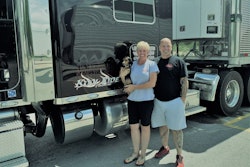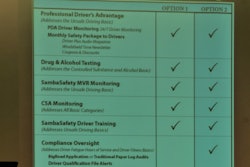 Frequent driving into large cities is one of many factors that can drive up an operator’s liability insurance. This photo, published in Overdrive in 2013, shows a Western Star LowMax owned by Pete Demarest negotiating the streets of Manhattan, one of Demarest’s destinations for hauling equipment for big entertainment productions.
Frequent driving into large cities is one of many factors that can drive up an operator’s liability insurance. This photo, published in Overdrive in 2013, shows a Western Star LowMax owned by Pete Demarest negotiating the streets of Manhattan, one of Demarest’s destinations for hauling equipment for big entertainment productions.The biggest chunk of an independent’s insurance costs is liability coverage, which pays for injuries and property damage from a wreck.
For over-the-road drivers, the Federal Motor Carrier Safety Administration requires $750,000 in primary or auto liability coverage. However, most shippers and brokers do not do business with trucking companies that carry less than $1 million in liability coverage. Certain hazmat haulers, especially those hauling chemicals, are required to have $5 million in liability coverage.
Liability coverage costs have increased markedly. Premiums for a $1 million liability policy now can range from around $6,000 to $16,000 or more a year.
The 2008 recession caused insurance companies to reduce premiums, says Bob Holtzman, president of California-based Western Truck Insurance Services.
“The marketplace was competing for what business was still there, and rates got really low,” he says. As the economy rebounded, he adds, insurers were slow to react and started taking losses “well in excess of premiums.”
In the last three to four years, insurers increased rates. Holtzman says rates are now much higher than the low that was seen around 2011 and are expected to remain at that level for the foreseeable future.

That “high” level, though, is relative. Holtzman says most insurance companies still run their commercial trucking business at combined ratios of over 100%. At 105%, for example, every $100 the insurance company brings in costs them $105.
As the economy has gotten hot in recent years, there have been more motorists on the road and more freight. These are possible factors in what the insurance community calls “nuclear verdicts,” Holtzman says, in which small accidents end up with large settlements in court.
Such verdicts point to the need for tort reform, says David Owen, president of the National Association of Small Trucking Companies. The absence of that reform affects the rising costs of liability insurance, he says.
“Ambulance-chasing lawyers are sucking the blood out of trucking,” Owen says. “They’re taking absolutely frivolous lawsuits and running into settlements because of the system. It’s cheaper to pay the fraudulent claim than to fight it.”
Some of the bigger factors affecting an independent’s liability rates are the type of freight, age of equipment, typical length of haul and states normally driven through. If you’re going up the East Coast or to places such as Chicago and Los Angeles and other urban centers frequently, your insurance rates will be higher because of the associated risk.
 Liability insurance rates have been rising for new and established independent owner-operators as insurance companies try to make up for rate reductions introduced during the 2008 recession. Staying free of accidents and violations is one of the best ways to get lower rates, especially for new carrier entrants.
Liability insurance rates have been rising for new and established independent owner-operators as insurance companies try to make up for rate reductions introduced during the 2008 recession. Staying free of accidents and violations is one of the best ways to get lower rates, especially for new carrier entrants.Other factors concern the driver: home base, age, driving record, length of trucking experience, insurance claim history and length of time with the same insurer.
Drivers with trucks under 15 years old often don’t have a problem getting insured, Holtzman says. Insurers often won’t accept older trucks or will want them inspected.
Following the good times seen by independents in the last couple of years, the pace of leased operators getting their operating authority has increased. Unfortunately, though, obtaining liability coverage has become a major hurdle for those seeking to make that step.
“The reality is that liability insurance for new authorities has historically been a segment served by a limited number of carriers,” says Lou Holmes, a product manager for Progressive, which still serves that market.
“That dynamic continues to exist today” and has gotten worse,’ he says. “Feedback from our agency partners suggests that over the last several years, companies have tightened their underwriting appetite in part to address some of the commercial auto profitability issues.”
Because of that tightening, Holmes says, many insurance companies have instituted stricter requirements on operating experience.
The best thing a new authority operator can do to get the best rate possible, Holtzman says, is to narrowly define your operation. Determine who your main shipper is going to be, the states you will run through and other specifics.
“If you can deal directly with shippers rather than brokers, that can be a big help,” Holtzman says. “You’ll be able to tell the insurance company that you’re working with one shipper giving you all your work.”
The more experience you have behind the wheel of a truck, the better you’ll look to insurers as well, especially if your record shows no at-fault accidents or violations. Holtzman also suggests a prospective new carrier entrant get a reference letter from their current employer to show insurance companies. A solid reference on safety and dependability can help lower your rate.
Holtzman says that after the first year, if you keep your nose clean regarding accidents and violations, you should be able to see your premium drop a little. However, it usually takes two years to see a noticeable difference and have preferred insurance carriers open up to you.
Other forms of liability insurance
While auto liability is the only type of liability insurance required by FMCSA, other forms of liability insurance can further protect independents.
GENERAL LIABILITY insurance covers incidents that the driver is responsible for that happen away from the insured vehicle. If you travel with a four-legged furry companion, this type of insurance would cover you if your pet were to bite someone.
CARGO LIABILITY covers anything that happens to the cargo while in transit. Auto liability typically doesn’t cover damage to the cargo, so cargo liability insurance covers that gap in case of damage from an accident, fire, theft, reefer breakdown and more.
POLLUTION LIABILITY is an option for hazmat haulers. Depending on the insurance company, coverage for pollution, usually defined as a continuous seepage, can be added as an endorsement to an existing liability policy or it can be purchased separately.
Lowering your rate
Taking steps to enhance safety, such as completion of the National Association of Small Trucking Companies’ Management and Safety Program, can help new authorities look better to insurers, says NASTC President David Owens.
“I think our MSP and New Entrant Survival Training are some of the fastest, most measurable ways to get lower rates,” Owen says. “If you spend some money on safety, put decals on your truck to say ‘How am I driving?’, doing drug testing and things like that, you will be viewed as a better risk.”
Progressive recently launched its Smart Haul program, which allows its owner-operator and small fleet customers to receive discounts if they agree to share data from their electronic logging devices.
“With Smart Haul, available in select states, truckers share the information on their ELD with Progressive to earn savings on their commercial truck insurance premium,” says Progressive’s Lou Holmes. “Qualifying truckers save an average of $1,384 as a new business.” Those with above-average safety rates can receive larger discounts.
Also, while dashcams – both road- and driver-facing – may not lower your insurance premiums, they can help you avoid lengthy lawsuits and unfair verdicts if the video proves you were not at fault.
Another way to reduce your insurance premium is to go with a higher deductible on your policy. It’s wise to assess the deductibles on all your insurance policies to ensure that you can cover all front-end costs in case one event necessitates filing more than one claim.










